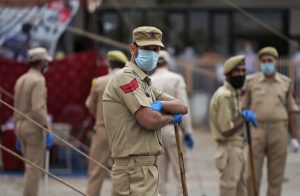In August 2019, the Indian government stripped Jammu and Kashmir of its autonomy – a status enjoyed by the state under Article 370 of the Indian Constitution after its merger with the Indian Union in 1947. The region was also stripped of its statehood and bifurcated into two new union territories – Jammu and Kashmir, as well as Ladakh – under the direct rule of New Delhi. Nearly a year later, the Kashmir Valley is still grappling with this momentous change even as it stares down further uncertainty stemming from the rapid spread of the COVID-19 pandemic, just as in other parts of India.
In the lead-up to the unilateral decision and subsequent announcement of these extraordinary steps from New Delhi last summer, a fear psychosis had swept across the region, with panic and chaos ruling the streets. People made a beeline to shops to stockpile essentials, while tourists fled after an alert from the authorities about a potential terror attack. Even the annual Hindu pilgrimage, Amarnath Yatra, was abruptly ended. These unprecedented developments, along with the rapid deployment of additional 10,000 troops in the region, indicated that something serious was afoot.
Amid a total communications blackout and curfew, Kashmiris woke up to a new reality on August 5, 2019 – their region’s special status was history, along with its statehood. The news reached them through TV channels, the only communication available to Kashmiris at the time. Yet almost a year later, nothing seems to have changed in Kashmir, proving the age-old adage that “the more things change, the more they stay the same.” The lockdown and curfew have continued as people have been forced to stay at home – first in the aftermath of the August 5 situation and now due to the coronavirus pandemic, which has catapulted the region to further precariousness.
The removal of Article 370 was perceived by locals as a significant loss, as the constitutional provision allowed Jammu and Kashmir to have its own constitution, a separate flag, and independence over all legislative matters except foreign affairs, defense, and communications. It also defined permanent residentship in the former state under Article 35A, which barred nonresidents from buying or owning immovable property or applying for government jobs or scholarships.
The ruling Bharatiya Janata Party (BJP) had time and again proclaimed that Article 370 was a major hindrance for development in Jammu and Kashmir and a fundamental cause of corruption. But the regional mainstream party, the National Conference (NC), counters the claim, saying that the BJP built up a narrative that Article 370 or 35A were in place exclusively to protect Muslims.
“It was as protective for Muslims in Kashmir as it was for Hindus in Jammu or Buddhists in Ladakh,” Imran Nabi, spokesperson for the NC, told The Diplomat. “Article 370 was never a barrier for the development in J&K. In the pre-militancy era, we had a lot of multinational companies operational in Kashmir. With the onset of militancy these companies had to vacate because of the unfavorable situation and not Article 370.”
One thing that has worked in India’s favor is that no major public rallies or open protests against the abrogation of Article 370 emerged. However, locals attribute this to the communication ban, the arrest of mainstream and separatist leaders, and heavy security deployments.

































